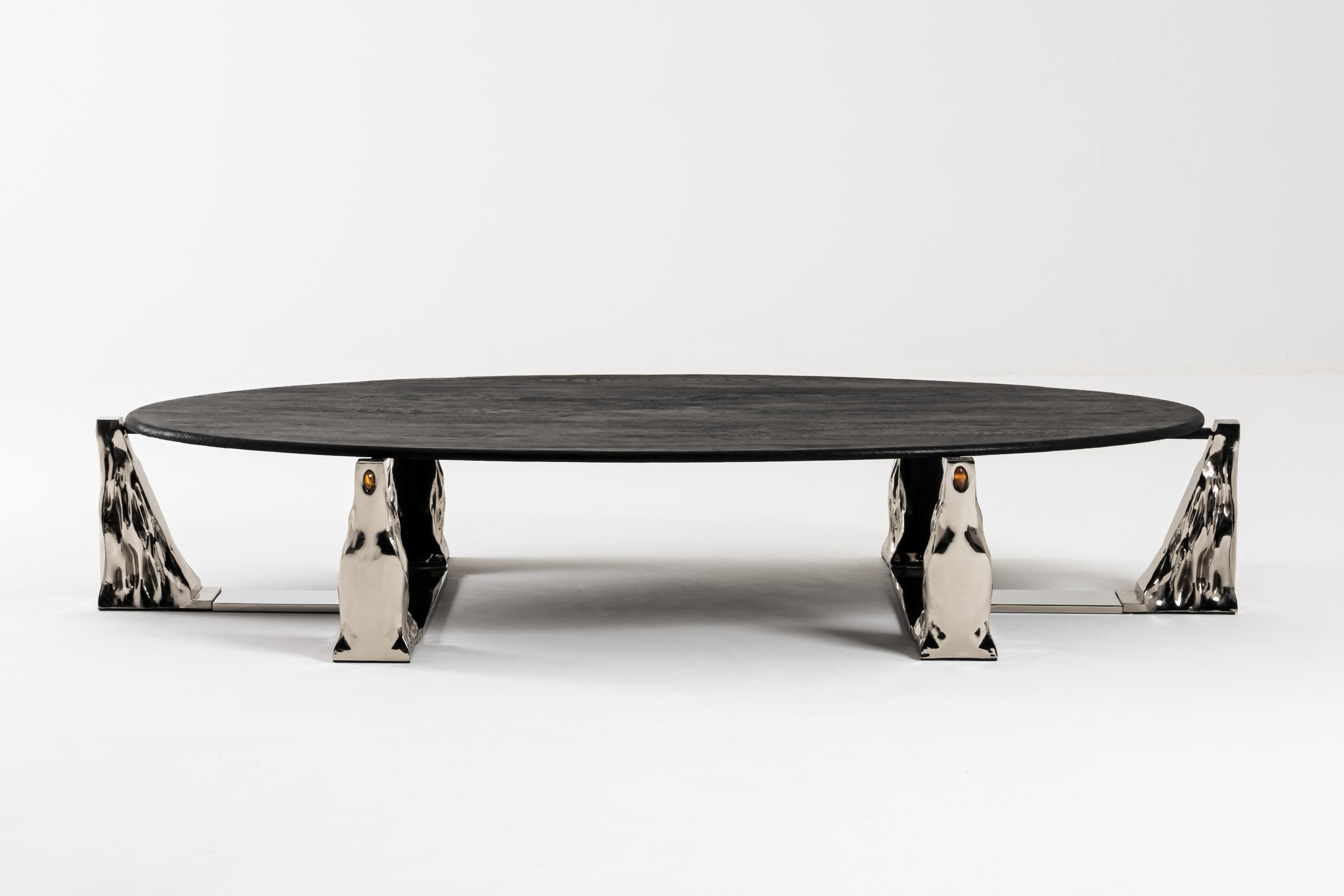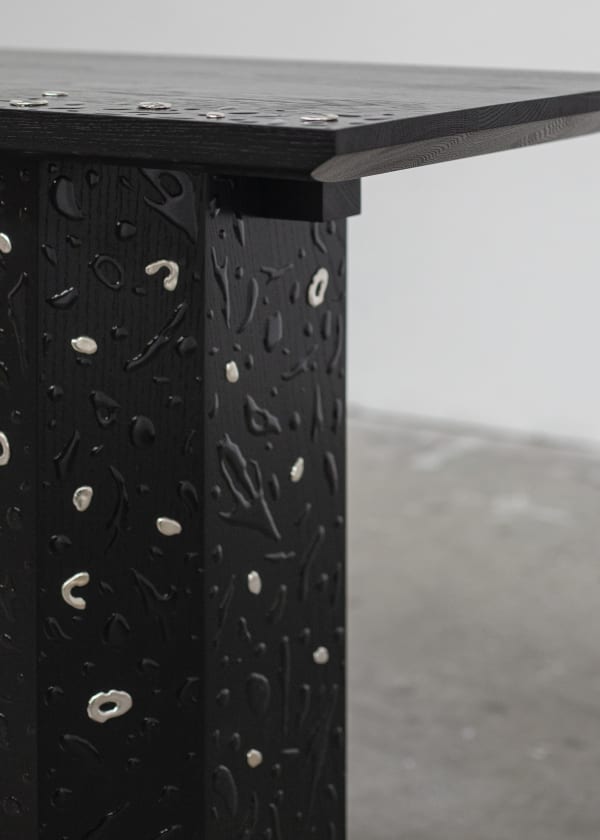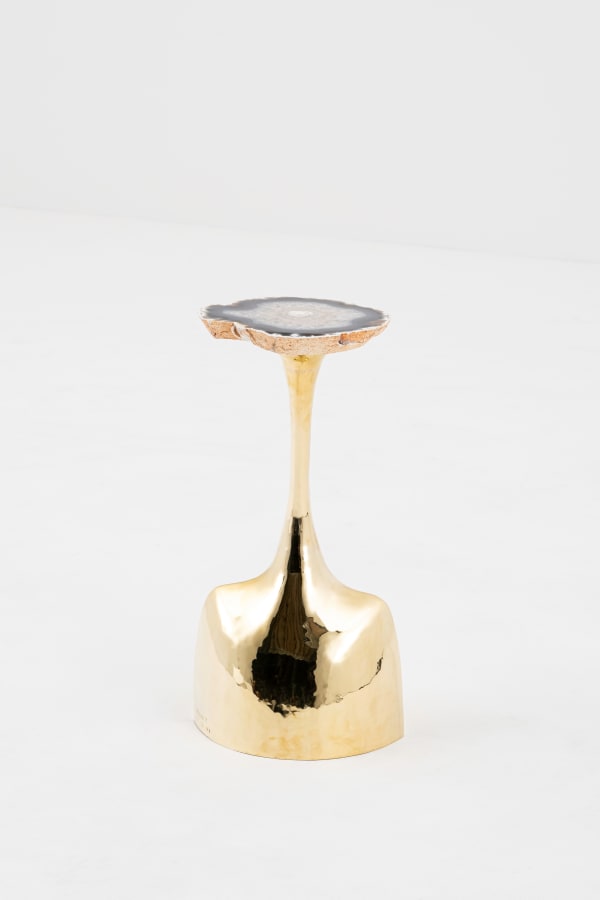-

-
Presented for the occasion of MAZE Design 2025, to take place in Basel, Switzerland on June 16th and 17th, the Galerie Gastou exhibition brings together a selection of sculptural works defined by symbolic weight, material tension, and a strong sense of presence. From the carved gravitas of Jean Touret and Emile Gilioli to the luminous sensuality of Omar Chakil and Philippe Hiquily, each piece asserts its own poetic logic. Historical works by André Dubreuil and Jean-Claude Farhi enter into dialogue with emerging designers like Quentin Vuong and Ghislain Ayoub, revealing shared concerns with gesture, craftsmanship, and the passage of time. The presentation offers a rhythm of contrasts — raw and refined, archaic and modern, intuitive and precise. Each work stands on its own, while together they compose a compelling portrait of material intelligence and formal audacity.
Download the show catalogue
-

-
Jacques Adnet
Parchement sideboard, 1937
Among the highlights of the presentation is a masterpiece of 1930s French modernism: a 1937 parchment sideboard by Jacques Adnet. This sideboard remains one of the most accomplished articulations of Adnet's vision: modern and luxurious, but not ostentatious. An exceptional example of Art Deco rationalism, the composition is defined by its restrained geometry and enriched by a tactile interplay of finishes: parchment-wrapped panels edged with a gilded metal, offset by a black lacquered base.
Parchment, as stated in Alain-René Hardy and Gaëlle Millet's "Jacques Adnet", appears early in Adnet’s work — already in 1933, at the height of the modernist period, he was using this fine, untanned goatskin (or sheepskin). But it was in 1937, with the nesting tables presented at the Exposition, and over the following years, that he began to adopt this material more regularly. The choice aligned perfectly with the refined aesthetic he embraced at that time. Just as he favored light woods, Adnet showed a marked preference for the ivory tones of parchment, which he used to sheath delicate cabinets and vanity pieces, subtly enhanced with gilt bronze accents.
-

André Dubreuil
"Octagonal" mirror, 2011
A particular highlight of this selection is a rare mirror by André Dubreuil: the “Octagonal Mirror” created in 2011, an exceptional example from the artist made from steel and hammered copper, featuring the original patina. Dubreuil's signature baroque accents are highlighted, with the frame displaying a spattering of freeform openings encircling medallions of enameled metal, along with petals of smooth, polished copper. This mirror stands as a key example of Dubreuil’s singular metallic poetry, forged at the intersection of function, fantasy, and form. Despite the apparent exuberance of the interior details, the composition remains strikingly coherent, framed within the octagonal exterior — the composition held together by the density of its materials and the rigor of Dubreuil’s touch.
-

Philippe Hiquily
"Coque" armchair for Henri Samuel, 1975
Also to be unveiled in the selection is a new variation of the iconic "Coque" armchair by Philippe Hiquily. Originally created in the early 1970s for the celebrated decorator Henri Samuel, this sculptural armchair exemplifies Hiquily’s instinct for balance between figuration and abstraction, sensuality and strength. The new model, now entering edition for the first time, introduces a notable inflection to the archetype: a sculpted back in hammered brass, rising into a pronounced crest. The historical provenance of the model, linked to Samuel’s uncompromising eye and Hiquily’s own artistic rigor, places it firmly within the lineage of postwar French design at its most refined and radical.
-
-
Jean Touret
"Jean-Baptiste" sculpture, c. 1980
A towering presence sculpted from a single piece of pinewood, "Jean-Baptiste" reveals the essential clarity and strength that define Jean Touret’s sculptural language. Each incision, curve, and silhouette carries the quiet force of Touret’s hand: direct, intuitive, and without embellishment. Standing over two and a half meters tall, the sculpture imbues a near-liturgical stillness. Both powerful and intimate, "Jean-Baptiste" is emblematic of Touret’s ability to infuse humble materials with a timeless gravity — simultaneously sculptural and spiritual.
-

André Dubreuil
"Perles" candelabra, c. 1990
The "Perles" candelabra designed by André Dubreuil exemplify his distinctive fusion of ornamental exuberance and structural precision. Produced between 1988 and 1990, the model stands among his most emblematic creations — rigorous in construction yet unmistakably personal in aesthetic. The tulip-like steel cages, studded with hand-fixed glass beads, evoke thorns or spores and rest on five-legged hammered bronze bases anchored by a central gilded sphere. Drawing from baroque, botanical, and tribal references, the design remains irreducibly Dubreuil in spirit. The tension between delicacy and aggression, transparency and armor, reflects his radical approach to the decorative object. Though the exact number produced is unknown, fewer than fifty were made, contributing to their rarity and making them among the most sought-after works in his œuvre.
-
Ettore Sottsass
"Clair de Lune" totem, 1991
Produced in a limited edition by Mirabili in Florence, the "Clair de Lune" totem belongs to a significant body of totemic works created by Ettore Sottsass, beginning in the 1980s, as the designer moved beyond the Memphis Group toward more sculptural and symbolic forms. These totems, of which "Clair de Lune" remains one of the most iconic examples, reflect Sottsass’s interest in ritual objects and his desire to reconnect design with emotional, spiritual, and cultural meaning. Composed of stacked glazed ceramic elements on a laminated wood base, the piece recalls the verticality and chromatic intensity of his earlier Memphis creations, yet stands apart through its more contemplative tone and subtler visual language.
-
-
Philippe Hiquily
"Gombert" console, 1980
The "Gombert" console was first conceived by Philippe Hiquily in 1980 for the French collector André Gombert. Two tapering brass forms rise from the floor to support a floating slate top, their silhouettes hollowed and drawn taut with a sense of internal tension. As in many of Hiquily’s designs, the piece engages not only with visual rhythm, but with the mechanics of poise — a legacy of the artist's lifelong passion movement and articulation. While the console recalls similar works from the period, the "Gombert" console asserts its own identity through scale, material contrast, and the precision of its sculptural line. More than an accent or a support, it is a composition in space — at once functional and autonomous, suspended between architecture and sculpture.
-
-

Omar Chakil
"Uraeus Birth Chairs", 2025
Sculpted in solid blocks of veined alabaster, Omar Chakil’s "Uraeus Birth Chairs" embody the artist’s ongoing engagement with sacred forms, cosmological dualities, and regenerative forces. Drawing on ancient Egyptian iconography, the chairs reference the “uraeus” — the cobra of divine protection and sovereign power — reimagined as an animating energy embedded in the object itself. Each chair is a unique variation, suggesting not only functionality but a performative, almost liturgical role. Chakil, whose heritage bridges Egypt, Lebanon, and France, infuses these pieces with a deep sense of cultural syncretism. The warm, translucent stone adds to the aura of mystery and reverence, refracting light with a skin-like softness that heightens the bodily allusions. While resolutely sculptural, these chairs are ultimately vessels — for myth, for memory, and for the quiet assertion of ancestral presence through form.
-
-

Jean-Claude Farhi
"Backgammon" game table, 1970
The iconic "Backgammon" game table by Jean-Claude Farhi stands as a bold example of the artist’s sculptural language, bridging the aesthetics of geometric minimalism, kinetic art, and the playful exuberance of 1970s design. Made entirely of high-gloss plexiglas, the piece demonstrates Farhi’s fascination with industrial materials and precision finish, as well as his belief in art as a space for pleasure, movement, and interaction. Its monolithic form opens to reveal a fully integrated game board — one side a chess grid, the other a backgammon layout in vibrant inlays of orange, red, and black. Jean-Claude Farhi, a fixture of the post-war avant-garde in France, was first known for his monumental totems and kinetic works before turning to design. Among his forays into furniture, the Backgammon Table has emerged as his most emblematic, with examples held in notable private collections including those of Hubert Guerrand-Hermès and Yves Gastou.
-
-

Ghislain Ayoub
Coffee table, 2025
Blending the mythic and the mineral, Ghislain Ayoub’s work conjures timeless forms shaped by both instinct and geology. His 2025 coffee table, composed of cast chromed bronze, solid blackened oak, and inlaid amber with striking precision, features a sculptural bronze base, at once rugged and fluid, recalls geological formations, while the tabletop appears set into the base like a stone in a ring. A former specialist in the decorative arts, Ayoub draws from an expansive visual lexicon ranging from Caravaggio to Giacometti, the Wiener Werkstätte to bio-mechanical fantasy. He describes his aesthetic as “bio-archaïsm,” a term that captures the collision between raw materiality and poetic intention. This piece, like much of his work, feels less designed than excavated — an object at once modern and mythological, refined yet primordial.
-

André Dubreuil
"Perles" candlesticks, c. 1990
Another variation from the "Perles" series, this model shifts the composition vertically. Delicate yet assertive, the candlesticks stretch upward like metallic vines, each curve punctuated by hand-fixed glass beads. When lit, the beads catch and scatter the candle’s flame in shifting reflections, adding a flickering, almost prismatic dimension to the piece. Created around 1990 and produced in limited numbers by AD Decorative Arts Ltd., this model reflects Dubreuil’s continued exploration of form, symmetry, and movement. The baroque energy of the "Perles" series is distilled in a more linear gesture, all while retaining the tension between structure and flourish that defines Dubreuil’s work. Notably, similar pieces from the Perles series were selected by Peter Marino for his designs at Chanel’s flagship boutiques, a testament to their expressive force and enduring elegance.
-
Émile Gilioli
"Astrale" sculpture, 1966
At the height of the 20th century, Émile Gilioli stood among the foremost figures of lyrical abstraction in French sculpture, alongside Jean Arp, Constantin Brâncusi, and François Stahly. One of the most striking expressions of Gilioli’s creation, rooted in a search for harmony between form and light, is found in the sculpture "Astrale". Carved from a single block of white marble, "Astrale" distills Gilioli’s sculptural language into its purest form. Its sharply faceted silhouette rises with quiet force, as though cut from air as much as from stone. Unlike the bronze editions of "Astrale", of which several examples exist, one of which notably in the collection of the Centre Pompidou in Paris, this marble version is a unique piece.
-
Quentin Vuong
"Console 01", 2024
A continuation of the After the Rain series, "Console 01" deepens Quentin Vuong’s poetic investigation of tactility and trace, pairing his signature hand-sculpted oak with a new material dialogue. Translucent resin drops appear suspended on the surface, like rainfall frozen in time. With this new console, Vuong contrasts the fluidity of the resin with drops of cast sterling silver — precious inclusions that emerge like fragments embedded in stone, subtly punctuating the grain of the wood and enriching the chromatic and textural interplay on its surface. The console’s slender form and chamfered edges reflect Vuong’s refined approach to proportion, while the sculpted detailing anchors the piece in a language of craftsmanship and touch.
-

Monique Rozanès
"La Lunche Blanche", 2025
A striking example of Monique Rozanès’s sculptural exploration of transparency, light, and visual rhythm, "La Lune Blanche" is crafted from perfectly transparent altuglas, and features delicate blades of white that seem to appear and vanish depending on the viewer’s position. These angled fragments catch and scatter light, creating shifting layers of shadow and reflection that animate the work from within. Both architectural and elusive, the sculpture invites a constantly evolving perception, rooted in movement and the play between volume and empty space.
-
Philippe Hiquily
"Henri Samuel" side table, 1974
Merging sculptural elegance with functional design, the 1974 "Henri Samuel" side table is a quintessential expression of Philippe Hiquily’s creative vocabulary.The table’s gently contoured base — broad at the hips and tapering at the neck toward the top — echoes a bodily presence that reappears across the works conceived during his long-standing collaboration with legendary decorator Henri Samuel. Through Samuel’s discerning eye, Hiquily’s biomorphic forms gained a context that heightened their expressive power — at once bold, intimate, and refined. With its luminous brass body and crystalline agate top, this piece exemplifies Hiquily’s gift for contrast: between nature and artifice, abstraction and allusion, the sensual and the structural.
-
Agnès Debizet
"Art Nouveau" sconce, 2023
Agnès Debizet’s creations, exploring the expressive potential of ceramics beyond the boundaries of function, often emerge as enigmatic hybrids — at once organic and architectural — marked by undulating silhouettes, rough textures, and a deep sensitivity to materiality. The "Art Nouveau" sconce represents a notable divergence from this aesthetic vocabulary. More ornate than earlier works, the fixture is animated by a vibrant interplay of color and light, with crystalline glass fused into the crevices of the ceramic surface. When lit, the hues shift from aquatic greens and blues to incandescent yellows, enveloping the surrounding space in an almost underwater glow. This rare departure underscores Debizet’s versatility, revealing a more theatrical register within her richly tactile and sculptural universe.
-
-

Omar Chakil
"Gros Guillaume" stool, 2025
Omar Chakil’s "Gros Guillaume" stool is a sculpted volume in the artist's signature alabaster — dense yet luminous, elemental yet refined. The stool furthers Chakil’s exploration of symbolic materiality, imbuing a seemingly simple form with layered potential: sculptural, architectural, and sensorial. Carved from Egyptian alabaster onyx, the form feels both ancient and contemporary, its softened geometry catching and diffusing ambient light through the semi-translucent stone.



























